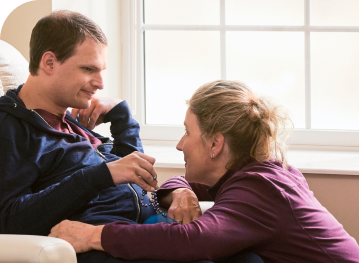An accurate diagnosis can make a real difference to your patients living with LGS1,2
Patients with LGS may reach adulthood without a specific diagnosis. At any age, an appropriate diagnosis can lead to more targeted care1,3
A specific diagnosis can help
when setting expectations and planning for future care with patients and caregivers.1
Treatment plans can be personalized
to a patient's particular conditions.1
Access to treatment can be improved
with a specific diagnosis of a patient's condition.2
Clinical features of LGS may delay or impede diagnosis:
Presentation is variable
sometimes without traditional signs and symptoms of LGS at onset.1,4,5
LGS changes over time
with different seizure types that evolve as patients age.1
Details of medical history may be lost
during transfer from pediatric to adult care, and characteristic EEG features may no longer be present by adulthood.2,3
The classic diagnostic triad is often used for initial diagnosis1,3:
Multiple seizure types
Cognitive impairment
Abnormal EEG
Symptoms change with age; therefore, this triad cannot be solely relied on. At any age, an appropriate diagnosis can lead to more targeted care and better outcomes.
By adulthood, ~50% to 75% of patients diagnosed with LGS during childhood may no longer display all of the clinical and EEG features typically used to diagnose the syndrome.3
LEARN MORE

Steven, at age 32 | EPIDIOLEX patient living with LGS
The signs and symptoms of LGS change over time, confounding diagnosis
IDENTIFYING LGS ACROSS AGE GROUPS
|
YOUNG CHILDREN (symptoms emerge: 2-8 years; peak onset: 3-5 years)5,6 |
ADOLESCENTS AND ADULTS |
|
SEIZURE |
|
|
SEIZURE FREQUENCY |
|
|
EEG |
|
|
NEUROLOGICAL ISSUES |
|
|
Other common hallmarks of LGS2,3:
- Persistent seizures despite trial of 2 or more ASMs
- Helmet/safety precautions to prevent seizure-related injuries
If your patients exhibit any of these signs or symptoms, consider evaluating them for LGS. The cognitive and behavioral issues associated with LGS can be just as challenging for families and caregivers as the seizures themselves.1
The information provided is not intended to supersede independent clinical judgment or institutional protocols.
Similar resources

LGS data
EPIDIOLEX® (cannabidiol) significantly reduced drop/total seizure frequency in patients living with LGS
See the data
clobazam in LGS
Drop seizure reduction in patients with LGS taking concomitant clobazam was evaluated in a prespecified exploratory analysis10
Review the data





